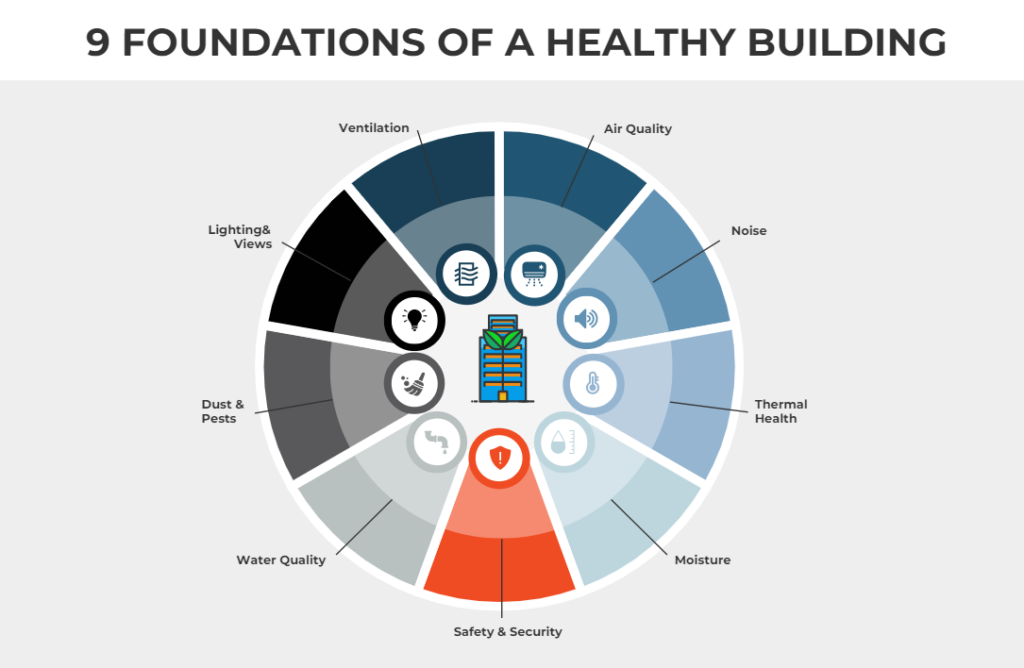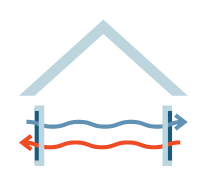
What is IFM? What are its benefits? Here is a comprehensive guide of everything you need to know about Integrated Facility Management (IFM).

Did you know the average full-time worker takes two million breaths yearly at work? This shows why healthy buildings matter.
Poor indoor air quality, low ventilation, and chemical exposure from cleaning can harm building users. These factors also affect overall health. Creating safer, healthier environments that help to redefine how occupants experience and perceive a building is critical. So, what makes a building healthy? And what role does integrated facility management play in achieving and maintaining a healthy building?
There are a few simple foundational elements that make up a healthy building. Harvard School of Public Health created “The 9 Foundations of a Healthy Building”, as a practical guide to healthy indoor environments.

Why are these foundational elements of a healthy building the most important? And how does integrated facilities management play a vital role in achieving and maintaining the foundations of a healthy building? A facility manager needs to consider building occupant health, wellness and comfort. But they also need to consider how the building can operate as efficiently as possible. According to a survey by IFMA, “utility cost is the largest component of a facility’s operating cost.” Running a close second is maintenance costs, followed by janitorial costs.
A holistic approach to healthy buildings is best because all foundational elements are deeply connected. Managing one directly affects the others.
An experienced facility management service provider is essential for reducing energy use and carbon emissions. A robust Building Management System (BMS) supports these efforts. Together, they help identify cost savings and improve comfort. They also enhance the overall well-being of your building’s occupants.
A BMS optimizes building systems based on occupancy patterns and employee preferences. It also provides 24/7 monitoring and reporting. The system aggregates data from core systems for a complete view of building assets. This visibility helps identify actual costs and improvement opportunities. Over time, a BMS supports environmental and sustainability goals. It can even help your facility progress toward net-zero.

The current ventilation standard only ensures “acceptable” air quality, despite decades of evidence supporting higher outdoor air ventilation rates.
Research has shown a direct link between the working environment and performance. A study conducted by Harvard “has shown that substandard ventilation rates negatively impact cognitive function”. Buildings require ventilation to bring in fresh outdoor air and dilute pollutants from occupants and products. When ventilation rates are low, people often describe the air quality as stuffy and unpleasant. Not only does this make the indoor environment uncomfortable to work in but the increased pollutants can cause an array of harm. A limited amount of ventilation in an indoor space can also increase the transmission rate of respiratory infections or harmful pathogens. This was something that came to the forefront with the recent COVID-19 pandemic.
Having the right balance of ventilation that supports optimal Indoor Air Quality (IAQ) and managing energy consumption are critical to a healthy building. An HVAC system takes outdoor air, heats or cools the air for the building, and then mixes it with existing indoor air to improve the overall ventilation of the building. This mix of intake air versus outgoing air determines the amount of heating and cooling required, which increases energy consumption.
An experienced facility management service provider can help you take a smart approach to ventilation by optimizing your air intake to keep energy costs low while still achieving good IAQ. They can also ensure that your ventilation systems operate properly and provide acceptable IAQ for the current occupancy level for each space.

Not only does poor IAQ harm occupant health and well-being, it also negatively impacts productivity. The World Green Building Council reported that offices equipped with an outdoor air supply ventilation source experienced reduced absenteeism rates as much as 35%.
IAQ depends on the presence and abundance of pollutants in the indoor environment that may cause harm. When IAQ is poor, occupants can experience building-related illnesses such as asthma, fatigue, irritation, headache or even Sick Building Syndrome (SBS). Poorly understood and most often unrecognized, SBS costs companies millions every year through employee absenteeism, decreased productivity and even increased healthcare premiums.
Creating strategies to measure and improve IAQ is a key factor to a healthy built environment. In an integrated facility service model, the provider utilizes a Computerized Maintenance Management System (CMMS) to schedule and record operations and preventive or planned maintenance activities on facility equipment. A dedicated FM partner will regularly monitor your HVAC systems and schedule proactive ongoing maintenance.
To help manage IAQ, FM experts can implement solutions to increase ventilation (fresh air intake) and air filtration and disinfection. They can also provide seasonal adjustments accounting for outdoor air supply in cold and hot weather. An Electronic Air Cleaner (EAC) improves overall air quality and connects to the BMS for filter alerts and maintenance. You can also install air quality sensors throughout the building and monitor them through the BMS dashboard. These sensors deliver real-time insights into areas with optimal air quality and areas that need more fresh air. The proper operation of IAQ measuring equipment and calibration is critical to achieving optimal IAQ.
Vacuum cleaners with HEPA filters can prevent contaminants from releasing into the air. Proper floor matting can prevent contaminants from making their way into the building and eventually into the air. Using the right equipment and safe cleaning supplies and chemicals are key initiatives that help improve overall indoor air quality. Taking an integrated approach to managing your facility can account for how all these foundational elements impact each other and how to best manage them individually and together.

Don’t overlook thermal comfort—it may influence office workers’ performance more than job stress or job satisfaction.
The definition of thermal comfort is “the condition of mind that expresses satisfaction with the thermal environment and is assessed by subjective evaluation”. The term ‘thermal health’ encompasses all of the impacts of thermal conditions on health, including mortality, that goes beyond just “comfort”. Temperature is a factor that often directly affects the comfort of building occupants. Several factors influence indoor temperatures, including building design, geography and orientation, occupant density, ventilation strategies, structure, and ventilation mode.
Air quality and thermal comfort go hand in hand, which is why having an integrated facility approach is beneficial. To improve air quality and comfort, share occupancy data with the BMS to adjust HVAC settings proactively. The BMS actively controls humidity and temperature, optimizing both in real time. It also supports specialized cleaning by identifying where and when it’s needed, reducing traffic and improving safety.
An experienced FM service provider can ensure you are implementing the right building control strategy to properly manage and maintain thermal comfort. They will consider the configuration of a building, its materials, and building fabrics and how that plays a role in space planning and management. It’s important for the temperatures to be monitored and logged in each zone and room, which can require additional sensors.
Space management solutions can include a network of IoT-enabled sensors and other devices that can include imaging and thermal monitoring sensors for area-specific people counting, active infrared to count people flow, and desk sensors to identify availability. Your facility management partner can provide optimizations and recommendations for things such as force flow heaters that are typically in the entryways and end of hallways to ensure airflow and efficient, individualized room temperature control in all areas of the building.

Water is easily the most pervasive offender when it comes to risks to your infrastructure – 51% of property insurance claims in Canada stem from water.
Moisture control is fundamental to the proper functioning of any building. According to Harvard, entrance of water into damaged, poorly designed, and improperly maintained buildings has been identified as the main source of building-related illness from mold exposure.
Researchers identified that dampness and moisture-related indoor exposures are of primary concern for preventing asthma and other respiratory conditions among both sensitized and unsensitized individuals alike. Dry buildings lead to discomfort – maintaining a targeted level of humidity and finding the right balance are critical to achieving a healthy building.
Establishing a mold and moisture management plan is crucial to maintaining good IAQ. Maintaining the proper moisture level and monitoring humidity levels, while adapting these for changes in seasonality is a key part of the plan. Building managers must plan inspections—from roof to drains—to catch leaks and protect the building’s structure and systems.
A facility management partner builds a proactive asset plan that tracks lifecycles and schedules repairs to extend asset life. When water issues arise, your FM partner acts fast, mobilizing resources to limit damage and keep your building safe.
Another great way to regulate and add moisture to a building is to install a living wall. Not only can this be a focal point for building users that can contribute to wellness but it also improves IAQ in the space. A single potted plant removes a portion of common airborne toxins in a space. A living wall can contain over a thousand plants, all of which filter air and in addition create energy-rich oxygen.

Dust acts as a reservoir for a variety of harmful agents – outdoor particles that penetrate indoors, viruses, bacteria, chemicals, allergens, building materials, dander, fabric fibers, and flakes of paint with lead.
Many contaminants residing in dust and lead can be harmfully exposed to humans and have a direct impact on their health. The primary concern from pests and domestic animals is that they introduce allergens to the indoor environment which can cause an immune response in adults and children.
Dust management is an important element of a healthy building. For example, if the appropriate cleaning is not being done in your building to keep dust levels at a minimum this can create a buildup that will then cause your HVAC system to need to work harder to produce a healthy indoor environment. Technicians can ensure the right filters are being used that account for efficiency, resistance to airflow, and dust-holding capacity. Studies have shown that re-circulated air tends to have a larger proportion of lint than does outdoor air, but proper filtration might reduce dust and lint in the space, resulting in lower housekeeping costs.
When it comes to pests, nearly all infestations can be traced back to one simple issue: access. Your FM partner can inspect the building to determine where access points are and then create a pest control plan that will take preventative measures to avoid any infestation. They can deploy green, non-toxic techniques that will minimize the use of pesticides.

Maslow’s Hierarchy of Needs tells us that safety and security are fundamental to our ability to thrive, coming only after the basic needs of food and water.
Indoor security threats are continuously evolving. Building managers need to consider and address a complex variety of existing and emerging risks that can arise from unauthorized entry to a building. When a person feels secure, it can positively impact their mental health. Feelings of safety may be influenced by the presence of security guards and additional building safety measures.
Having security guards and controlled access within a building are just a few ways that safety and security can be prioritized. Along with having the appropriate security measures in place within a building, another element that can be overlooked is the fire and life safety systems. These systems are continually operating and require ongoing testing and maintenance from specialist technicians.
Additionally, an FM service provider can ensure emergency and disaster recovery plans are in place that accounts for the unique needs of your building. This would not only include emergency plans for how building users can evacuate a space if there is a security or safety issue but also emergency plans for HVAC or other systems that provide protocols on how to identify, rectify and minimize equipment failures that can disrupt operations within an area of a building or building-wide.

Contaminated drinking water is one of the leading causes of disease globally. Normal building operation can also often result in stagnation (e.g., offices over the weekend, unused hotel rooms).
Drinking water may be contaminated by improper treatment – poor maintenance of distribution systems, malfunctioning wastewater treatment systems, accidental sewage releases, pesticides, fertilizers and more. Despite regulations on water quality in Canada, it’s difficult to predict the exact composition of water coming out of your faucet. Things less regulated like atrazine (a pesticide), microplastics and lead, which are very commonly used in buildings, may be present in the tap water and can impact health.
Building water management plans help guide prevention and response to water quality issues, especially opportunistic pathogen growth. An experienced FM service partner can help you focus on the most important aspects related to water quality in your building and on quickly achievable goals. A building should have a legionella management plan as well as a detailed water management plan. A water management plan should account for the full lifecycle management of all water systems. To create this, facility managers would have a full understanding of the water flow in the building and be able to identify critical inspection points that require scheduled water testing for proactive maintenance.

A recent survey of more than 1,200 senior executives and non-executive employees found that 53% of employees report that ambient noise reduces their work satisfaction and productivity.
Noise enters building interiors from outside sources such as aircraft, road traffic, trains, lawn mowers etc. Indoors, noise can be generated from a building’s mechanical and HVAC systems, office equipment, vacuum cleaners, industrial machinery, or conversations among occupants. Studies of the non-auditory effects of noise exposure have observed that increased noise levels are associated with higher systolic and diastolic blood pressure, changes in heart rate, and hypertension.
An experienced FM service provider will take the time to understand the layout and components of your building and identify where noise reduction is required from both internal and external sources. Identifying these weak points, then mitigating them through adequate space planning and acoustic design are key for noise control within a healthy building.
For example, within a critical building if there’s a room located beside an x-ray machine that creates a lot of noise, the room would require soundproofing. Having your FM partner conduct regular audits and deploying plans that can help regulate and reduce noise throughout the building. Technologies like sound absorbing panels and white noise machines can also be used to further reduce noise.

Urban sprawl often leads to obstructed views of natural landscapes. Indoor spaces rely on electric lighting, which differs from daylight in intensity, spectrum, and timing. These differences can affect how people feel and function throughout the day.
The average North American person spends about 90% of their time indoors, which has important implications for the wellbeing of building occupants. Light levels typically experienced indoors can induce non-visual responses. It also has acute effects on our cognitive function and sleep. In any building, choose lighting that supports people’s rhythms—bright when needed, dim when it’s time to wind down.
Plan spaces to maximize exposure to the right light at the right time and avoid disruptive lighting when possible.
Your FM provider can look for areas where they can utilize soft lighting throughout a building versus using harsh white lighting. A lighting plan for a space will include considerations for lighting type, amount of light needed, and the ability users might have to adjust or change lighting in certain spaces for user comfort. A living wall is another great way to add indoor “views” to a space that may not have unobstructed outdoor views or lots of natural light. Additionally, maximizing window space and natural light can be a consideration if you are in a building development or renovation stage.
When you maintain the foundational elements of a healthy building, occupants experience real benefits.
These include better overall health, improved cognitive function, and enhanced well-being throughout the day. Creating and maintaining a healthy building doesn’t have to be hard.
Focusing on the nine foundations and managing them will help shape vibrant, healthy spaces for occupants inside. Team up with a facility management partner that understands how buildings impact both minds and bodies. Their insight helps you create spaces that feel good now—and stay that way well into the future.
Learn more about how we can you help you achieve and maintain a healthy building.
Dexterra Group Inc. cannot and does not warrant the accuracy, completeness, timeliness, non-infringement, merchantability or fitness for a particular purpose of any information available through these links and disclaims any opinions expressed on such sites.
And that’s fine with us - we work in both the U.S. and Canada. We just wanted to know if you prefer your words with or without a 'u'.